2017 Hyundai Santa Fe Sport heating
[x] Cancel search: heatingPage 448 of 614
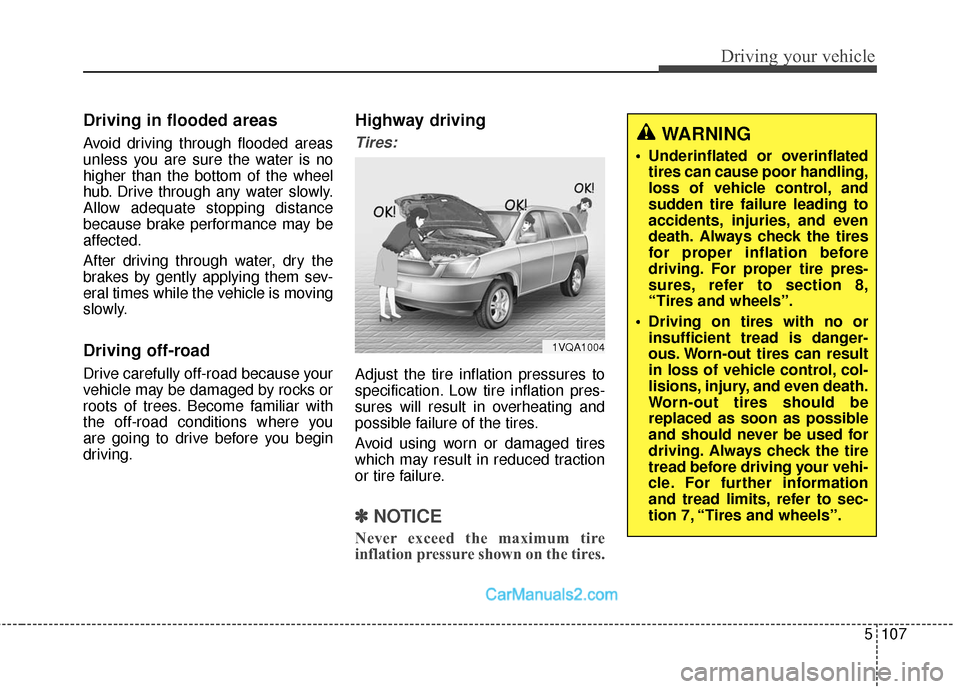
5107
Driving your vehicle
Driving in flooded areas
Avoid driving through flooded areas
unless you are sure the water is no
higher than the bottom of the wheel
hub. Drive through any water slowly.
Allow adequate stopping distance
because brake performance may be
affected.
After driving through water, dry the
brakes by gently applying them sev-
eral times while the vehicle is moving
slowly.
Driving off-road
Drive carefully off-road because your
vehicle may be damaged by rocks or
roots of trees. Become familiar with
the off-road conditions where you
are going to drive before you begin
driving.
Highway driving
Tires:
Adjust the tire inflation pressures to
specification. Low tire inflation pres-
sures will result in overheating and
possible failure of the tires.
Avoid using worn or damaged tires
which may result in reduced traction
or tire failure.
✽ ✽NOTICE
Never exceed the maximum tire
inflation pressure shown on the tires.
1VQA1004
WARNING
Underinflated or overinflated
tires can cause poor handling,
loss of vehicle control, and
sudden tire failure leading to
accidents, injuries, and even
death. Always check the tires
for proper inflation before
driving. For proper tire pres-
sures, refer to section 8,
“Tires and wheels”.
Driving on tires with no or insufficient tread is danger-
ous. Worn-out tires can result
in loss of vehicle control, col-
lisions, injury, and even death.
Worn-out tires should be
replaced as soon as possible
and should never be used for
driving. Always check the tire
tread before driving your vehi-
cle. For further information
and tread limits, refer to sec-
tion 7, “Tires and wheels”.
Page 449 of 614
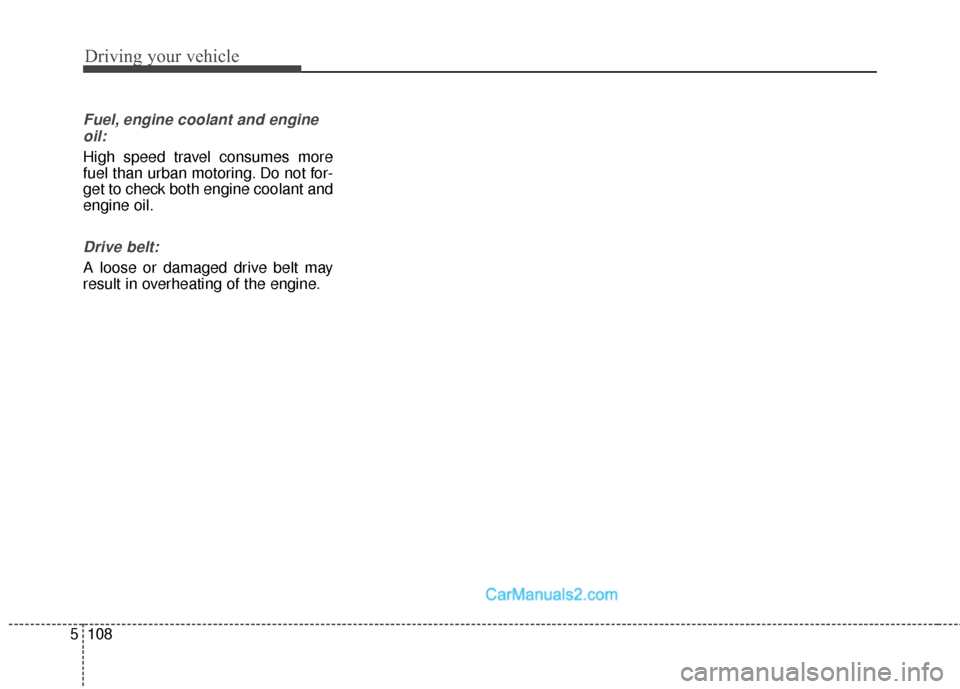
Driving your vehicle
108
5
Fuel, engine coolant and engine
oil:
High speed travel consumes more
fuel than urban motoring. Do not for-
get to check both engine coolant and
engine oil.
Drive belt:
A loose or damaged drive belt may
result in overheating of the engine.
Page 458 of 614
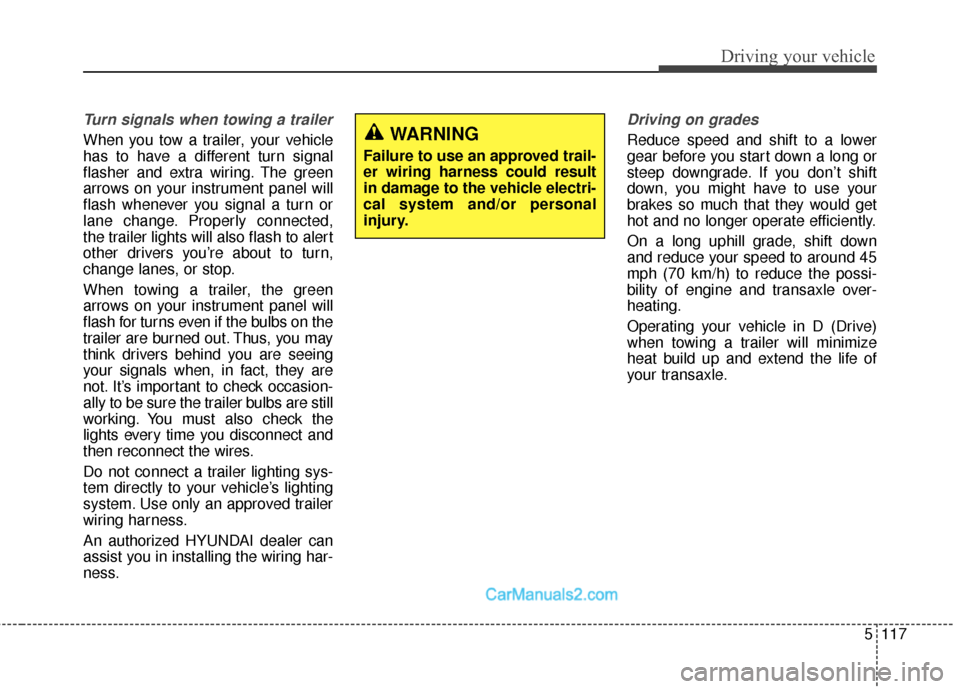
5117
Driving your vehicle
Turn signals when towing a trailer
When you tow a trailer, your vehicle
has to have a different turn signal
flasher and extra wiring. The green
arrows on your instrument panel will
flash whenever you signal a turn or
lane change. Properly connected,
the trailer lights will also flash to alert
other drivers you’re about to turn,
change lanes, or stop.
When towing a trailer, the green
arrows on your instrument panel will
flash for turns even if the bulbs on the
trailer are burned out. Thus, you may
think drivers behind you are seeing
your signals when, in fact, they are
not. It’s important to check occasion-
ally to be sure the trailer bulbs are still
working. You must also check the
lights every time you disconnect and
then reconnect the wires.
Do not connect a trailer lighting sys-
tem directly to your vehicle’s lighting
system. Use only an approved trailer
wiring harness.
An authorized HYUNDAI dealer can
assist you in installing the wiring har-
ness.
Driving on grades
Reduce speed and shift to a lower
gear before you start down a long or
steep downgrade. If you don’t shift
down, you might have to use your
brakes so much that they would get
hot and no longer operate efficiently.
On a long uphill grade, shift down
and reduce your speed to around 45
mph (70 km/h) to reduce the possi-
bility of engine and transaxle over-
heating.
Operating your vehicle in D (Drive)
when towing a trailer will minimize
heat build up and extend the life of
your transaxle.WARNING
Failure to use an approved trail-
er wiring harness could result
in damage to the vehicle electri-
cal system and/or personal
injury.
Page 459 of 614
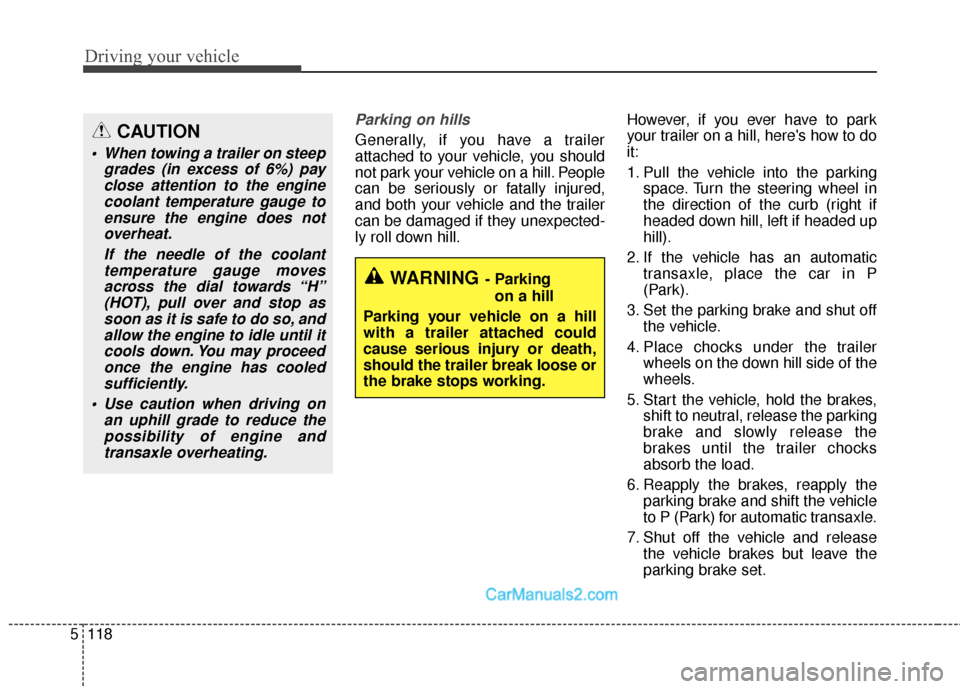
Driving your vehicle
118
5
Parking on hills
Generally, if you have a trailer
attached to your vehicle, you should
not park your vehicle on a hill. People
can be seriously or fatally injured,
and both your vehicle and the trailer
can be damaged if they unexpected-
ly roll down hill. However, if you ever have to park
your trailer on a hill, here's how to do
it:
1. Pull the vehicle into the parking
space. Turn the steering wheel in
the direction of the curb (right if
headed down hill, left if headed up
hill).
2. If the vehicle has an automatic transaxle, place the car in P
(Park).
3. Set the parking brake and shut off the vehicle.
4. Place chocks under the trailer wheels on the down hill side of the
wheels.
5. Start the vehicle, hold the brakes, shift to neutral, release the parking
brake and slowly release the
brakes until the trailer chocks
absorb the load.
6. Reapply the brakes, reapply the parking brake and shift the vehicle
to P (Park) for automatic transaxle.
7. Shut off the vehicle and release the vehicle brakes but leave the
parking brake set.
WARNING- Parking
on a hill
Parking your vehicle on a hill
with a trailer attached could
cause serious injury or death,
should the trailer break loose or
the brake stops working.
CAUTION
• When towing a trailer on steep grades (in excess of 6%) payclose attention to the enginecoolant temperature gauge toensure the engine does notoverheat.
If the needle of the coolanttemperature gauge movesacross the dial towards “H”(HOT), pull over and stop assoon as it is safe to do so, andallow the engine to idle until itcools down. You may proceedonce the engine has cooledsufficiently.
Use caution when driving on an uphill grade to reduce thepossibility of engine andtransaxle overheating.
Page 460 of 614
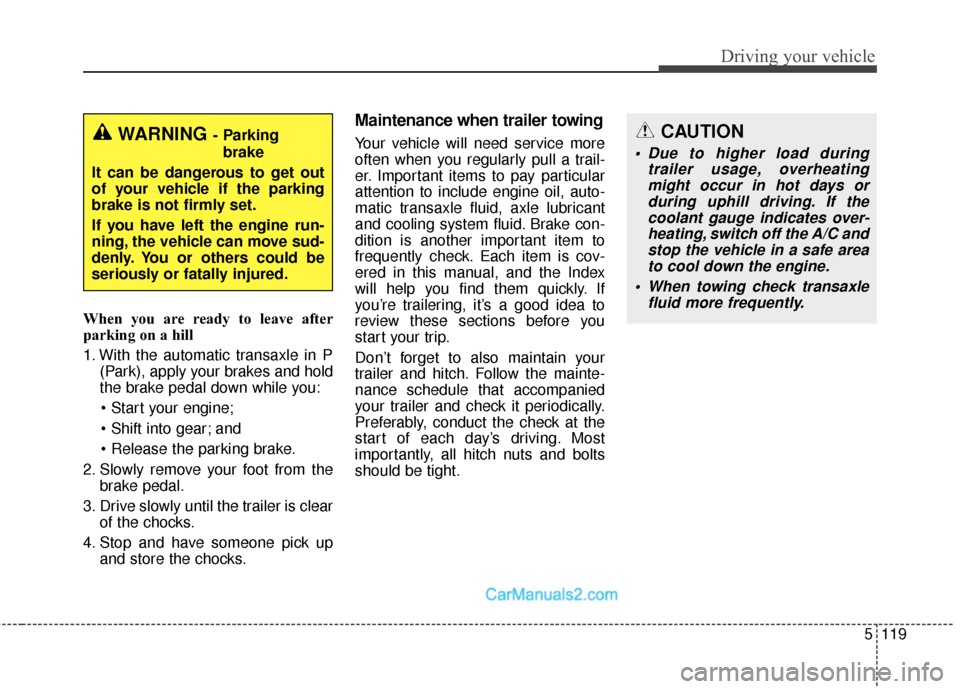
5119
Driving your vehicle
When you are ready to leave after
parking on a hill
1. With the automatic transaxle in P(Park), apply your brakes and hold
the brake pedal down while you:
and
2. Slowly remove your foot from the brake pedal.
3. Drive slowly until the trailer is clear of the chocks.
4. Stop and have someone pick up and store the chocks.
Maintenance when trailer towing
Your vehicle will need service more
often when you regularly pull a trail-
er. Important items to pay particular
attention to include engine oil, auto-
matic transaxle fluid, axle lubricant
and cooling system fluid. Brake con-
dition is another important item to
frequently check. Each item is cov-
ered in this manual, and the Index
will help you find them quickly. If
you’re trailering, it’s a good idea to
review these sections before you
start your trip.
Don’t forget to also maintain your
trailer and hitch. Follow the mainte-
nance schedule that accompanied
your trailer and check it periodically.
Preferably, conduct the check at the
start of each day’s driving. Most
importantly, all hitch nuts and bolts
should be tight.WARNING- Parking
brake
It can be dangerous to get out
of your vehicle if the parking
brake is not firmly set.
If you have left the engine run-
ning, the vehicle can move sud-
denly. You or others could be
seriously or fatally injured.CAUTION
Due to higher load during trailer usage, overheatingmight occur in hot days orduring uphill driving. If thecoolant gauge indicates over-heating, switch off the A/C andstop the vehicle in a safe areato cool down the engine.
When towing check transaxle fluid more frequently.
Page 477 of 614
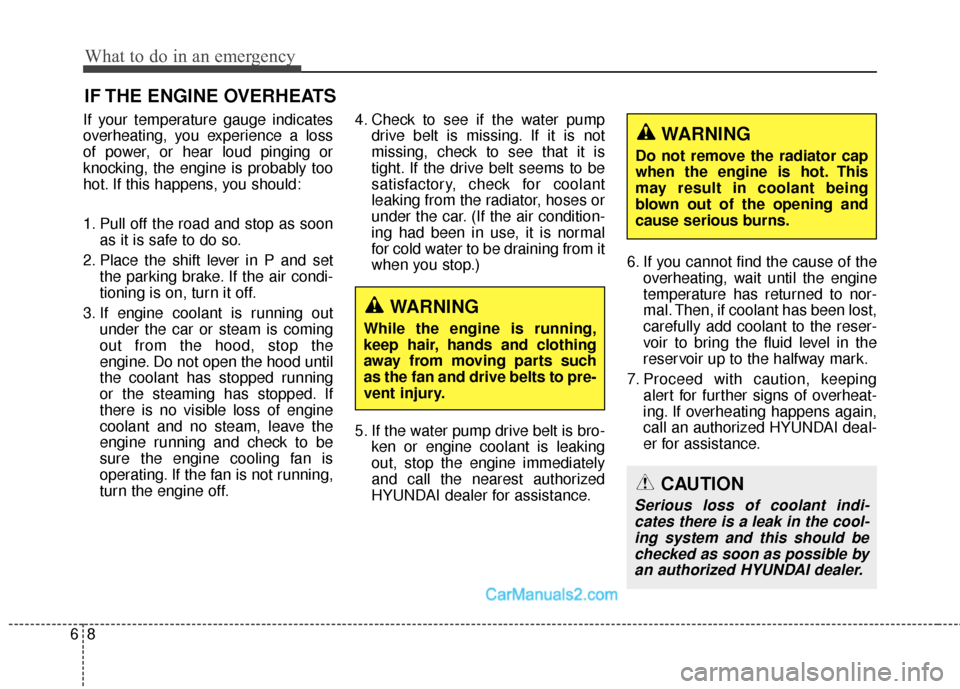
What to do in an emergency
86
IF THE ENGINE OVERHEATS
If your temperature gauge indicates
overheating, you experience a loss
of power, or hear loud pinging or
knocking, the engine is probably too
hot. If this happens, you should:
1. Pull off the road and stop as soonas it is safe to do so.
2. Place the shift lever in P and set the parking brake. If the air condi-
tioning is on, turn it off.
3. If engine coolant is running out under the car or steam is coming
out from the hood, stop the
engine. Do not open the hood until
the coolant has stopped running
or the steaming has stopped. If
there is no visible loss of engine
coolant and no steam, leave the
engine running and check to be
sure the engine cooling fan is
operating. If the fan is not running,
turn the engine off. 4. Check to see if the water pump
drive belt is missing. If it is not
missing, check to see that it is
tight. If the drive belt seems to be
satisfactory, check for coolant
leaking from the radiator, hoses or
under the car. (If the air condition-
ing had been in use, it is normal
for cold water to be draining from it
when you stop.)
5. If the water pump drive belt is bro- ken or engine coolant is leaking
out, stop the engine immediately
and call the nearest authorized
HYUNDAI dealer for assistance. 6. If you cannot find the cause of the
overheating, wait until the engine
temperature has returned to nor-
mal. Then, if coolant has been lost,
carefully add coolant to the reser-
voir to bring the fluid level in the
reservoir up to the halfway mark.
7. Proceed with caution, keeping alert for further signs of overheat-
ing. If overheating happens again,
call an authorized HYUNDAI deal-
er for assistance.
WARNING
While the engine is running,
keep hair, hands and clothing
away from moving parts such
as the fan and drive belts to pre-
vent injury.
CAUTION
Serious loss of coolant indi-cates there is a leak in the cool-ing system and this should bechecked as soon as possible byan authorized HYUNDAI dealer.
WARNING
Do not remove the radiator cap
when the engine is hot. This
may result in coolant being
blown out of the opening and
cause serious burns.
Page 604 of 614

Index
2I
A/V Mode ......................................................................4-\
86
Active ECO system ......................................................5-100
Adaptive Front Lighting System (AFLS) ....................4-136
Additional safety precautions ........................................3-74
Advanced smart cruise control system ..........................5-72
Air bag ........................................................................\
....3-47Air bag collision sensors ............................................3-68
Air bag inflation conditions ........................................3-69
Air bag non-inflation conditions ................................3-71
Air bag Hazards ............................................................3-2
Air bag warning label ..................................................3-75
Air bag warning light ..................................................3-50
Curtain air bag ............................................................3-66
Driver's and passenger's front air bag ........................3-60
Occupant classification system ..................................3-54
Side air bag ..................................................................3-65
SRS Care ....................................................................3-73\
SRS components and functions ..................................3-51
Air cleaner ......................................................................7-\
34
Air Conditioning refrigerant label ................................4-156
Air conditioning system....................................................8-5
All wheel drive (AWD) ..................................................5-21
Antenna ........................................................................\
4-182
Anti-lock brake system (ABS) ......................................5-43 Appearance care..............................................................7-82
Exterior care ................................................................7-82
Interior care ................................................................7-87
Armrest (Rear seat) ........................................................3-20
Audio system ................................................................4-182 Antenna......................................................................4-\
182
Steering wheel audio control ....................................4-182
AUTO light position ....................................................4-129
Automatic climate control system ................................4-157 Automatic heating and air conditioning ....................4-158
Manual heating and air conditioning ........................4-159
Auto hold ........................................................................\
5-40
Automatic emergency braking (AEB) ............................5-56
Automatic transaxle ........................................................5-14 Manual shift mode ......................................................5-17
Shift-lock override ......................................................5-18
Automatic turn off function ..........................................4-141
Aux, USB and iPod
®port ............................................4-176
A
Page 610 of 614
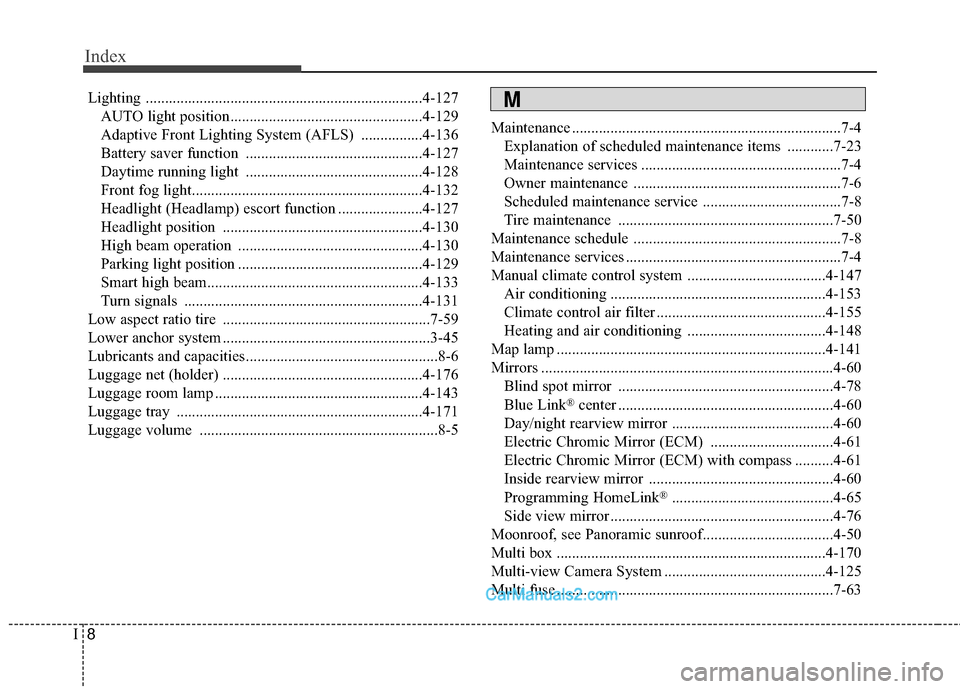
Index
8I
Lighting ........................................................................\
4-127AUTO light position..................................................4-129
Adaptive Front Lighting System (AFLS) ................4-136
Battery saver function ..............................................4-127
Daytime running light ..............................................4-128
Front fog light............................................................4-132
Headlight (Headlamp) escort function ......................4-127
Headlight position ....................................................4-130
High beam operation ................................................4-130
Parking light position ................................................4-129
Smart high beam........................................................4-133
Turn signals ..............................................................4-131
Low aspect ratio tire ......................................................7-59
Lower anchor system ......................................................3-45
Lubricants and capacities..................................................8-6
Luggage net (holder) ....................................................4-176
Luggage room lamp ......................................................4-143
Luggage tray ................................................................4-171
Luggage volume ..............................................................8-5 Maintenance ......................................................................7-\
4
Explanation of scheduled maintenance items ............7-23
Maintenance services ....................................................7-4
Owner maintenance ......................................................7-6
Scheduled maintenance service ....................................7-8
Tire maintenance ........................................................7-50
Maintenance schedule ......................................................7-8
Maintenance services ........................................................7-4
Manual climate control system ....................................4-147 Air conditioning ........................................................4-153
Climate control air filter ............................................4-155
Heating and air conditioning ....................................4-148
Map lamp ......................................................................4-\
141
Mirrors ........................................................................\
....4-60 Blind spot mirror ........................................................4-78
Blue Link
®center ........................................................4-60
Day/night rearview mirror ..........................................4-60
Electric Chromic Mirror (ECM) ................................4-61
Electric Chromic Mirror (ECM) with compass ..........4-61
Inside rearview mirror ................................................4-60
Programming HomeLink
®..........................................4-65
Side view mirror ..........................................................4-76
Moonroof, see Panoramic sunroof..................................4-50
Multi box ......................................................................4-\
170
Multi-view Camera System ..........................................4-125
Multi fuse ........................................................................\
7-63
M